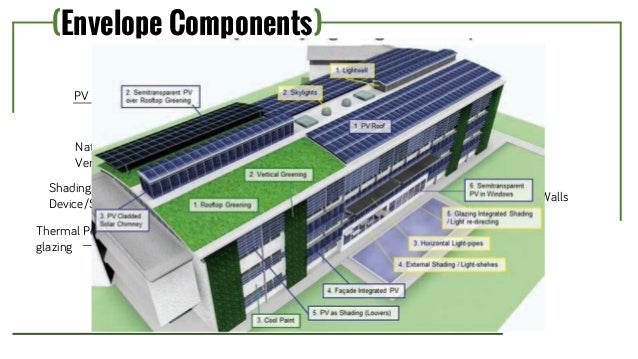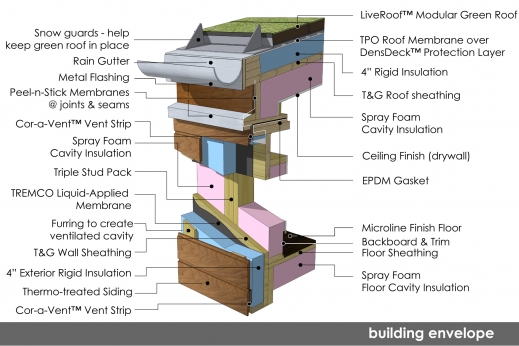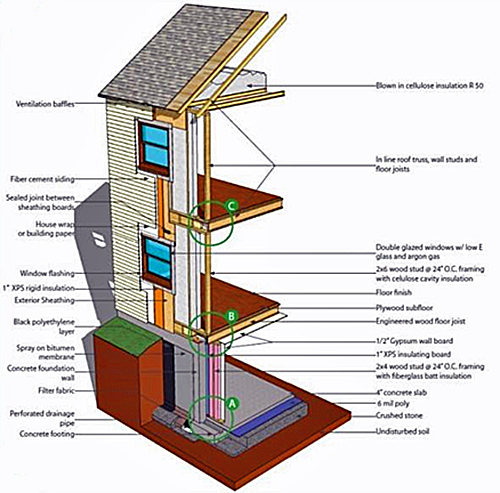
- Components of the building envelope code#
- Components of the building envelope professional#
- Components of the building envelope windows#
In consideration of these important details, an essential roof system accessory is sealant. Additionally, roof penetrations for HVAC equipment must be checked during inspection. If you need to learn more about flat roofs, check out this complete survey of low-slope roofing in the guide to Choosing a Flat Roof.īeyond the membrane itself, proper installation of the many components that meet the commercial roof membrane at its termination point is critical. The choice of these system types will depend upon specification, budget, climate and environmental considerations. The importance of the roof to a building is paramount.Ĭommercial roofs, as shown in the picture above, come in a variety of system types, including asphalt-based, single ply, rubber and metal. In the case of most commercial, industrial or educational institutions, roofs are usually flat, or low-slope. It’s meant to close the envelope securely, keeping the contents safe from outside elements. A building’s roof is like the seal to an envelope.

This report thoroughly outlines all of the components of the building envelope and offers an exhaustive list of related resource pages related to air barriers, air quality and mold prevention, and sustainability and wind safety, to name a few categories. National Institute of Building Sciences (NIBS) developed a comprehensive guide for exterior envelope design and construction for institutional and office buildings in late 2016 under guidance from the past Federal Envelope Advisory Committee.
Components of the building envelope professional#
Professional assessment, diagnosis, design and management of the building envelope can save money, decrease energy usage, lengthen the life of building materials and improve the environment within.Īs part of their “Whole Building Design Guide,” the U.S. While this applies to virtually any building, our focus for this article is on commercial and industrial buildings.

This includes three main systems: the roof, the wall (including doors and windows) and below-grade waterproofing elements. The building envelope consists of the parts of a building that keep the weather out and conditioned environment in. This article is intended to provide an overview of the building envelope and details about its components and products. The only time that I can think of where the expense of a tight building envelope is not justified is in the housing of livestock, or an equipment shed that houses mechanical machinery resistant to the climate.An Introduction to the Building Envelope Products & Systems Monday, AugUnderstanding the Building Envelope In almost every case, it is better to have the operator and occupants of the building control the ventilation. It does require more ventilation, but a building with a tight envelope can have mechanically or manually controlled natural ventilation.Ī tight building envelope is an energy efficient building envelope. As a building inspector, I have to say that I think a tight envelope is the best for any type of residential or commercial building.
Components of the building envelope code#
The market value of an efficient building is much better than one that is inefficient, and as code standards continually improve, this extra market value will surely increase. In a hot or cold climate, the building envelope is the best area to find cost effective energy efficiency improvements.
Components of the building envelope windows#
Depending on the climate, the windows usually make an ROI in five to seven years.įurthermore, over 40% of the thermal losses in a building are attributed to the building envelope. In most cases, the payback time for the investments in constructing a tight building are in the three to five year range.

On a new build, it is cost effective to make an envelope tighter when the costs of energy are taken into consideration.

Besides the windows, the building materials that go into making a tight building envelope are not that expensive. This allows the builder to afford things like demand controlled ventilation systems that increase ventilation automatically as carbon dioxide levels rise.Īpril 18, I would agree that a tight building envelope would be the best type of building envelope for the money. Because of this, the energy use per square foot begins to decrease significantly as the building square footage increases. After a certain point, the square footage of a building increases relatively faster than the buildings volume. I would just like to point out that the cost effectiveness of a tight building envelope in new construction increases as the square footage increases.


 0 kommentar(er)
0 kommentar(er)
